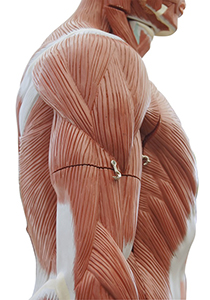Study Shows New Twist on Mind-muscle Connection
By Gaelan Melanson
February 7, 2018
 Researchers in the Department of Human Health and Nutritional Sciences have gained new insights into the fundamental properties that govern muscle activity and influence our day-to-day movement.
Researchers in the Department of Human Health and Nutritional Sciences have gained new insights into the fundamental properties that govern muscle activity and influence our day-to-day movement.
Prof. Geoffrey Power and his research group have discovered a unique interplay between our nervous system and a phenomenon that occurs during muscle contraction known as torque depression.
Muscle contraction is what drives human movement. For example, the movement associated with taking a drink involves contraction and shortening of the bicep muscles. This contraction generates a force called torque that causes the forearm to rotate at the elbow towards your mouth, and allows you to enjoy your morning coffee. But not all muscle contractions are created equal. During contractions where the muscle does not shorten, such as holding a travel mug at waist-level between sips, the muscle generates more torque compared to a muscle that had to shorten to match the same position. The lower amount of torque generated by shortened muscles is known as torque depression.
According to Power, TD is observable at every level of the muscle, from single muscle fibres to muscles of the entire body, but the interaction between TD and our nervous system during voluntary muscle contractions is not entirely understood.
“TD is a well-known concept that has been around since 1954,” says Power. “But what we don’t know is how TD influences our nervous system. For example, does TD change the way we tell our body to move?”
To answer this question, the team investigated how TD in the leg influences the ability of the brain and spinal cord to transmit voluntary muscle contraction signals. Participants in the study were immobilized and instructed to flex their toes forward 40-degrees to create a TD state in their leg. Electrodes attached to the neck were then used to stimulate transmission of an electrical signal through the spine towards the muscle being contracted. Alternatively, electrical signals from the brain to the flexed muscles were induced by a process called transcranial magnetic stimulation. Detectors placed on each participants’ leg were then used to measure the strength of these signals coming from either the brain or spinal cord to their muscles. The experiment was then repeated when the participant’s leg muscle was not experiencing TD.
The researchers discovered that the spine was more “excitable” during TD compared to the brain, and could propagate stronger voluntary muscle contracting signals with less instruction to do so from the brain.
“We are showing that an intrinsic property we thought was limited to muscle actually has a huge implication on our ability to voluntarily generate force,” says Power.
This insight into the mind-muscle connection has many implications for understanding human activity, and could be used to develop a tool to help athletes improve physical performance or aid in rehabilitation of patients who are not able to generate enough muscle force for certain movements.
Jordan Grant and Caleb Sypkes also contributed to the project. Funding was provided by the Natural Sciences and Engineering Research Council.
Read the full article in the journal Physiological Reports.
Read about other CBS Research Highlights.